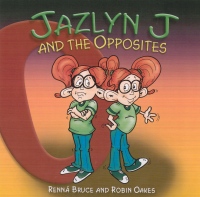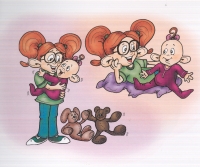| ________________
CM . . .
. Volume XV Number 18. . . .May 1, 2009 
 |
Jazlyn J and the Opposities.
Renná Bruce. Illustrated by Robin Oakes.
Guelph, ON: Jazlyn J and Company Inc. (www.jazlynj.com), 2009.
28 pp., pbk., $6.95.
ISBN 978-0-9781809-1-1.
Subject Headings:
Individual differences-Juvenile fiction.
Infants-Juvenile fiction.
Brothers and sisters-Juvenile fiction.
Preschool-grade 2 / Ages 4-7.
Review by Jonine Bergen.
** /4
|
| |
|

excerpt:
The phone rang and Jazlyn ran to the kitchen where Grandma J picked it up.
"A boy! It's a boy, Jazlyn!" Grandma J announced happily.
Jazlyn wasn't as happy. Just the opposite, she felt a little sad.
A boy? A brother? She was sure it was going to be a girl! A sister! A brother is the complete opposite of sister.
The prolific team of Renná Bruce and Robin Oakes have reached the letter "O' in their Jazlyn J series. This time, Jazlyn explores the concept of opposites as she waits for her new sibling to be born.
 Jazlyn is excited because today she is going to become a big sister. While she is waiting with her Grandma J for the big news, she imagines what the new baby is going to be like and what they will be able to do together through a series of opposite statements. Jazlyn is excited because today she is going to become a big sister. While she is waiting with her Grandma J for the big news, she imagines what the new baby is going to be like and what they will be able to do together through a series of opposite statements.
Jazlyn knows the baby is going to be a girl and is very excited. But, when the opposite occurs, and her mother has a baby boy, Jazlyn is disappointed. This baby is the opposite of what she expected - and the opposite of herself. But, Grandma J shows her that she and her baby brother, though opposites in some ways, also have a lot of similarities too.
Bruce and Oakes have intertwined the text and illustrations appropriately for a picture book meant to be used to be an example of a principle - opposites. Generally, each page has two opposite statements that are depicted through simple, primary coloured cartoons.
One of the strengths of this book is the simplicity of the text. Once Renná Bruce sets up the plot, her simple, conversational style allows the plot to be read simply as a story, or, it can be used as intended - as an instructional aide.
Following the theme of opposites, I have, to this point, listed some positive characteristics; now for the negative. The characters' facial features, particularly their ears, were extremely distracting for me. I also found the sentence fragments used to describe the opposites jarring. There were times that I had to reread a page because it lacked flow or the text didn't seem to match the illustrations. For example, when the text asks, "How will we know if she's too hot in that blanket? Or if she's too
cold?", the illustration is first of a baby wrapped up in the blanket shivering, then of a baby unwrapped looking hot; the text was opposite to the illustration.
In the end, though a fun story that a child can relate to with a positive message, Jazlyn J and the Opposites doesn't fulfill its role as an exemplar. The examples of opposites are good, but as a model, it is lacking the intrinsic grammatical structure and consistency necessary for a good educational model.
Recommended.
Jonine Bergen works as a library technician and teacher in Winnipeg, MB.

To comment
on this title or this review, send mail to cm@umanitoba.ca.
Copyright © the Manitoba Library Association. Reproduction for personal
use is permitted only if this copyright notice is maintained. Any
other reproduction is prohibited without permission.
NEXT REVIEW |
TABLE OF CONTENTS FOR THIS ISSUE
- May 1, 2009.
AUTHORS |
TITLES |
MEDIA REVIEWS |
PROFILES |
BACK ISSUES |
SEARCH |
CMARCHIVE |
HOME |

 Jazlyn is excited because today she is going to become a big sister. While she is waiting with her Grandma J for the big news, she imagines what the new baby is going to be like and what they will be able to do together through a series of opposite statements.
Jazlyn is excited because today she is going to become a big sister. While she is waiting with her Grandma J for the big news, she imagines what the new baby is going to be like and what they will be able to do together through a series of opposite statements.